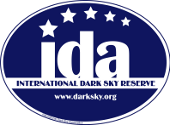International Dark Sky Reserve
 Due to minimal light interference and lack of water moisture, the NamibRand Nature Reserve (NRNR) offers one of the world’s best views of the night sky. On moonless nights, with the naked eye, thousands of individual stars can be seen, as can the Milky Way. Also visible are the Magellanic Clouds and the seldom seen zodiacal light (pictured right), a pyramid shaped glow viewed best soon after sunset and before dawn. The zodiacal light is sunlight reflected off countless small dust particles orbiting in the inner solar system. At certain times of the year perhaps the most elusive object in the night sky, a faint brightening of the zodiacal light opposite the Sun called the gegenschein, can be observed.
Due to minimal light interference and lack of water moisture, the NamibRand Nature Reserve (NRNR) offers one of the world’s best views of the night sky. On moonless nights, with the naked eye, thousands of individual stars can be seen, as can the Milky Way. Also visible are the Magellanic Clouds and the seldom seen zodiacal light (pictured right), a pyramid shaped glow viewed best soon after sunset and before dawn. The zodiacal light is sunlight reflected off countless small dust particles orbiting in the inner solar system. At certain times of the year perhaps the most elusive object in the night sky, a faint brightening of the zodiacal light opposite the Sun called the gegenschein, can be observed.
Many areas of the world now see only a few stars at night due to light pollution which occurs when artificial light is reflected back down to earth by minute particles of dust or liquid. Light pollution wastes energy, disturbs animals and ecosystems, is detrimental to astronomical observations, and causes humanity to lose a part of its heritage and culture. Many tourists visit Namibia with an interest in viewing the magnificent night sky therefore it is a valuable resource for the country. With increasing development there is a risk that the light pollution will also make the night skies of Namibia less spectacular unless they are protected.
NamibRand Nature Reserve, with NaDEET Centre as the educational core, implements strict measures to reduce the impact of lights. These efforts in night sky conservation have earned the Reserve Gold Tier certification from the International Dark-Sky Association (IDA) as Africa’s first International Dark Sky Reserve (IDA Press Release).
An "IDA “… is a public or private land possessing an exceptional or distinguished quality of starry nights and nocturnal environment that is specifically protected for its scientific, natural, educational, cultural, heritage and/or public enjoyment mission of a large peripheral area” (see www.darksky.org for more information).
NaDEET staff show visitors the wonders of the night sky both by naked eye and through a telescope. The threat light pollution poses and how to prevent it are also discussed. See the Protect Our Night Sky edition of the Bush Telegraph for more information.






